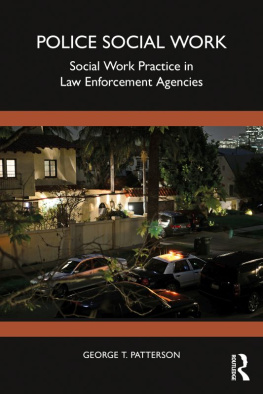
License Plate Readers
for Law Enforcement
Opportunities and Obstacles
Keith Gierlack, Shara Williams, Tom LaTourrette,
James M. Anderson, Lauren A. Mayer, Johanna Zmud
The research described in this report was sponsored by the National Institute of Justice and was conducted in the Safety and Justice Program within RAND Justice, Infrastructure, and Environment.
This project was supported by Award No. 2010-IJ-CX-K007, awarded by the National Institute of Justice, Office of Justice Programs, U.S. Department of Justice. The opinions, findings, and conclusions or recommendations expressed in this publication are those of the authors and do not necessarily reflect those of the Department of Justice.
Library of Congress Cataloging-in-Publication Data is available for this publication.
eISBN: 978-0-8330-8653-2
The RAND Corporation is a nonprofit institution that helps improve policy and decisionmaking through research and analysis. RANDs publications do not necessarily reflect the opinions of its research clients and sponsors.
Support RANDmake a tax-deductible charitable contribution at www.rand.org/giving/contribute.html
RAND is a registered trademark.
Cover image: Police car equipped with mobile ANPR produced by ELSAG North America (Mobile Plate Hunter 900). Kafuffle via Wikimedia; CC BY 2.0.
Copyright 2014 RAND Corporation
This document and trademark(s) contained herein are protected by law. This representation of RAND intellectual property is provided for noncommercial use only. Unauthorized posting of RAND documents to a non-RAND website is prohibited. RAND documents are protected under copyright law. Permission is given to duplicate this document for personal use only, as long as it is unaltered and complete. Permission is required from RAND to reproduce, or reuse in another form, any of our research documents for commercial use. For information on reprint and linking permissions, please see the RAND permissions page (www.rand.org/pubs/permissions.html).
RAND OFFICES
SANTA MONICA, CA WASHINGTON, DC
PITTSBURGH, PA NEW ORLEANS, LA JACKSON, MS BOSTON, MA
CAMBRIDGE, UK BRUSSELS, BE
www.rand.org
Preface

Since the use of license plate reader (LPR) technology is relatively new in the United States, opportunities and obstacles in its use in law enforcement are still under exploration. As the technology spreads, however, law-enforcement agencies, particularly those considering investing in an LPR system and other organizations focused on the information technology needs of law enforcement, may find the material in this report helpful. It provides an in-depth examination of the range of ways in which license plate scanners are used; the benefits and limits of LPR systems; and emerging practices for system operation. The RAND Corporations research approach, exploratory interviews with law-enforcement personnel, sought to gather information not just from police officers but also from the diverse people responsible for installing, maintaining, and operating the systems. This method allowed RAND to thoroughly characterize and examine license plate scanner issues to add to the knowledge base. The interviews explored salient issues concerning system implementation, funding, case uses, field procedures, technology issues, data retention policies, and privacy concerns. RAND believes these findings overall will add value to the discussion on this technologys utility. This work was sponsored by the National Law Enforcement and Corrections Technology Center of Excellence on Information and Geospatial Technology at the National Institute of Justice (NIJ). It should be of interest to law-enforcement personnel at all levels and is one in a series of NIJ-sponsored resources for police departments.
The RAND Safety and Justice Program
The research reported here was conducted in the RAND Safety and Justice Program, which addresses all aspects of public safety and the criminal justice system, including violence, policing, corrections, courts and criminal law, substance abuse, occupational safety, and public integrity. Program research is supported by government agencies, foundations, and the private sector.
This program is part of RAND Justice, Infrastructure, and Environment, a division of the RAND Corporation dedicated to improving policy and decisionmaking in a wide range of policy domains, including civil and criminal justice, infrastructure protection and homeland security, transportation and energy policy, and environmental and natural resource policy.
Questions or comments about this report should be sent to the project leader, Johanna Zmud (.
Figures and Tables

Figures
Tables
Summary

Financed largely by federal and state grants, law-enforcement agencies across the country have quickly been adopting a new technology to combat auto theft and other crimes: automated license plate readers. The license plate reader (LPR) system, which has portable and fixed units, can capture the image of a passing vehicle and compare its plates against official hotlists that show an array of infractions in which it may be involved or reasons why it may be of interest to authorities. After an alert is issued, the officer can then investigate the license plate of interest and decide whether to take further action.
Not only can the system alert officers with this actionable information, but it can also provide photos of the car or truck in question. This technology captures images of exponentially more vehicles than any single officer possibly can, and the information generated may also be stored in databases, allowing investigators potentially to analyze these data for more complex and open investigations of serious crimes.
Although this technology has spread rapidly in agencies nationwide, the dearth of deeper research means that police and policymakers may not possess sufficient, credible information to best assess the opportunities and challenges of these systems. Their initial grant funding will expire soon, meaning that already budget-strapped departments will be forced to make tough decisions about buying more such equipment, replacing or upgrading it, maintaining it, and expanding its use.
Further, as investigators see the potential of querying past records that the technology producesfor example, to track crime patterns or trends or in pursuit of criminal suspectsprivacy advocates have grown wary, and some lawmakers have imposed restrictions or outright bans on these systems or aspects of their use.
To forestall and address public concerns, agencies using the systems have struggled with new, complicated matters of technology management, including how and with whom they should share data, who may access it, and how long they might keep the information. Seasoned police officers, with major help from system administrators with information technology (IT) backgrounds, have had to figure out how to install, maintain, and repair cameras, computers, and servers and learn whether their high-tech systems will be compatible with installations of other departments in the area. Agencies have scrutinized their personnel and staffing and have developed system trainings for patrol officers and investigators. Those that have grappled with the technologys issues and know the systems best are already inching their way to resolutions.













